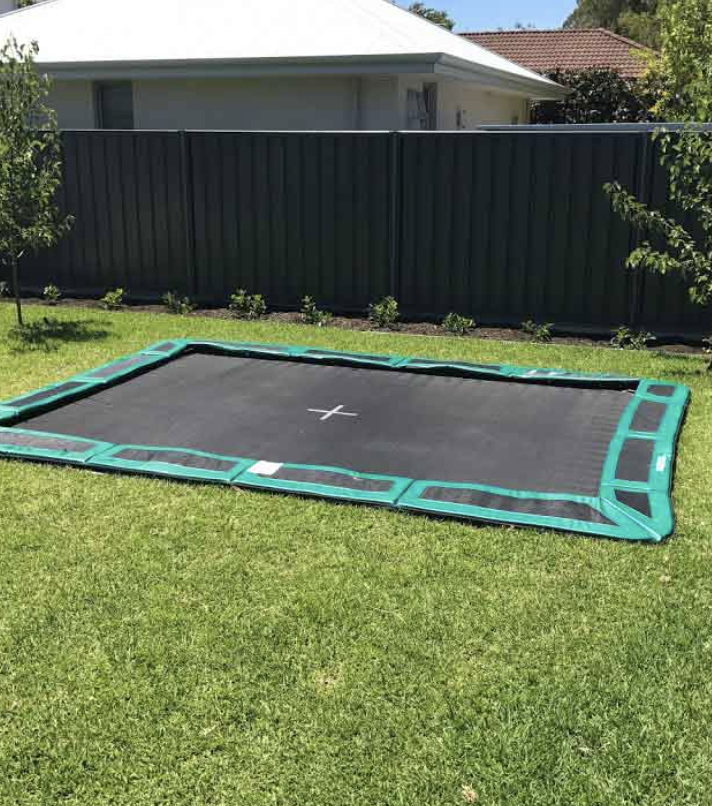Do you remember the good old days, where summers were spent playing outside, and not staring at screens all day? As a child, I spent most them jumping on my trampoline, under the shade of a giant pecan tree. I would practice gymnastics, and make up games (being an only child I was good at this) that would occupy me for hours! I actually taught myself my first back flip on a trampoline. It’s amazing I lived to tell about it! Several years ago, I got back into jumping on a trampoline to prepare for American Ninja Warrior, and I fell in love with it all over again. I purchased this mini tramp to train for some of the obstacles. After the first 5 minute session, I was so sore the next day especially my core, but it was so much fun. I began to regularly incorporate “rebounding” into my fitness routine. Just last year, I went all in and got a large in ground trampoline to give me more freedom to flip, twist and all the fun gymnastics stuff I like to play around with. A mini tramp though is all you need to get going.
In this post, I’ll be sharing with you eight amazing benefits of rebounding, aka jumping on a trampoline.
- Core Strength:
- Jumping on a trampoline requires constant engagement of the core muscles to maintain balance and control in the air. This engagement strengthens the core muscles, improving your posture and making other exercises and activities easier. You can target your core further with twisting jumps, pike jumps, and tuck jumps.
- Cardiovascular Fitness:
- Jumping on a trampoline is a great cardiovascular workout. According to a study published in the International Journal of General Medicine, trampoline exercise can increase aerobic capacity, improve oxygen uptake, and decrease resting heart rate. This improves overall cardiovascular fitness, which benefits your overall health and fitness. The repetitive jumping motion of trampolining also helps to increase blood flow and circulation throughout the body.
- Overall Strength:
- Trampolining engages multiple muscle groups throughout the body, making it an excellent total body workout. Studies show that trampolining can increase muscle strength and power in the lower body. You can also work your upper body by incorporating arm movements. Trampoline workouts can also improve muscular endurance, which is the ability of your muscles to work for an extended period without fatigue. Improved overall strength can improve your ability to perform daily activities and reduce the risk of injury. Some examples of trampoline exercises that target the lower body include squat jumps, scissor jumps, and box jumps.
- Balance and Coordination:
- As we age, our balance tends to decline, increasing the risk of falls and injuries. Trampolining requires a high level of balance and coordination, which can help reduce this risk. The unpredictable and dynamic movement of trampolining challenges your balance and coordination, forcing your body to adapt and improve. Improved balance and coordination can improve performance in other exercises and activities. Examples of trampoline exercises that target balance and coordination include single-leg jumps, blindfolded jumps, and handstand jumps.
- Lymphatic Drainage:
- The jumping motion of trampolining stimulates the lymphatic system, which is responsible for removing waste and toxins from your body. The lymphatic system relies on movement and muscle contraction to move lymphatic fluid through the body. The repetitive jumping motion of trampolining helps to stimulate this process, improving lymphatic drainage and immune function.
- Bone Density:
- Trampoline workouts involve jumping and landing, creating an impact on the bones. This impact stimulates bone growth and can improve bone density. According to research published in the Journal of Sports Science and Medicine, trampolining can increase bone density in the hip and spine, reducing the risk of osteoporosis.
- Pelvic Floor Health:
- Pelvic floor strength is essential for women’s overall health and well-being. Pregnancy, childbirth, and aging can weaken the pelvic floor muscles, leading to pelvic floor disorders such as incontinence. Trampolining can help to strengthen the pelvic floor muscles, reducing the risk of pelvic floor disorders. A study published in the Journal of Women’s Health Physical Therapy found that trampoline exercise can improve pelvic floor muscle strength in women with stress urinary incontinence. Trampolining provides a low
- Improved Mental Health: Trampolining can also benefit your mental health. Jumping on a trampoline can help to release endorphins, which are the body’s natural mood-boosters. Endorphins help to reduce stress and anxiety, and can improve overall feelings of happiness and well-being. Additionally, trampolining is a fun and enjoyable way to exercise, which can boost your motivation to stay active and improve your mental outlook. It so fun – and that is why I love it so much!! Definitely a happy way to exercise
If you’re just starting out, I recommend just doing 5 minutes and working up from there. In the literature I’ve read, you can get the lymphatic benefits from a session of 5 to 10 minutes. If I’m doing a longer session, I love listening to a podcast or audiobook to tag team some extra-brain engagement as well. Give it a go and bounce on in to a stronger fitter you!

0 COMMENTS